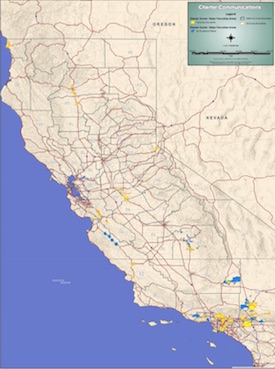
Charter offers broadband in the yellow areas, but not the blue. Click for a much bigger version.
A second, more detailed look at map analysis done by the Central Coast Broadband Consortium (full disclosure: I’m part of that effort) shows even more rural areas redlined out of broadband service by Charter Communications in California.
The technique is simple and not completely foolproof, but in the few places where the ground truth has been checked, the results have been borne out. The analysis started with the video franchise areas granted to Charter by the California Public Utilities Commission, under the 2006 law – DIVCA, for short – that allowed cable companies to replace local franchises negotiated city by city and county by county with a single, cable company-friendly statewide agreement.
Next step was to take the broadband service area reports that Charter submitted to the CPUC, and compare the two. The resulting map shows large areas, mostly in urban areas, where Charter has upgraded its analog systems to digital broadband capabilities. But the further you go from relatively affluent urban cores in the Los Angeles area and profitable medium-sized cities mostly along the U.S. 101 and I-5 corridors, the broadband gaps become bigger and more frequent.
Redlined communities include several in the Salinas Valley, Tulare County and the Inland Empire and nearby desert areas of southern California. Smaller pockets also appear, including Alturas in Modoc County, which wasn’t picked up at first, and peripheral areas adjacent to what appears to be most of Charter’s systems elsewhere.
It’s a far cry from the 99% digital upgrade claim made to the Federal Communications Commission and the “virtually all of its current customers in California” whopper offered to the CPUC by Charter as it seeks regulatory approval of its proposed purchase of Time Warner and Bright House cable systems.
